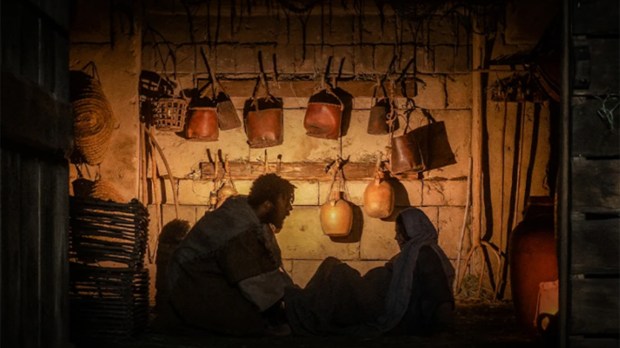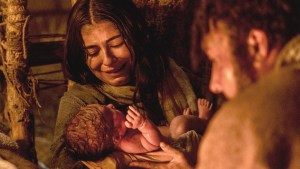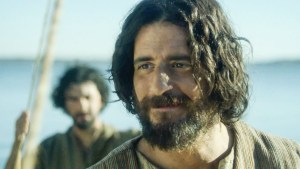The hit series, The Chosen, has released its second Christmas special, which will be in theaters throughout the United States from December 1-10.
The multi-season, crowdfunded series on Jesus, played by actor Jonathan Roumie, all started when director Dallas Jenkins produced a Christmas film for his evangelical church called “The Shepherds.” The Chosen‘s creators have partnered with Fathom Events to bring a special 2-hour Christmas with the Chosen: The Messengers to theaters. As a Catholic you might have questions or want to delve deeper. Here are ten things I thought about when I viewed the Christmas special.
1. What is the purpose of the music?
Christmas with the Chosen begins with an hour-long Christian contemporary Christmas music concert with some of the biggest names in the industry, including Catholic artist Matt Maher. Interspersed within the music are different reflections from the artists and segments of spoken word on the names of God. As you listen to the music, and perhaps even hum along, you might think to yourself, “When’s the episode going to start?” That might be because we miss the point of the music. When I spoke with Katherine Warnock, a producer for The Chosen, she told me that the Christmas special was meant to bring people to worship Jesus on account of the incarnation. Music is meant to lead us into prayer, meditation, and worship. Additionally, throughout Church history, hymns were a way people learned about God. Songs can be catechetical. As you listen to the music of Christmas, think about the words, what they mean in general but also for your life, and how they can lead you into worship.
2. What is a miracle?
You’ll hear the word miracle referenced in some of the early dialogues. We are familiar with miracles and sometimes have hoped for miracles in our life. We often refer to Christmas as a miracle, because the incarnate son of God was born in a miraculous way, and it’s quite miraculous that God would become a little baby. In our Catholic tradition, a miracle would be defined as an unexplainable, instantaneous, and long-lasting event in a person’s life. On the way to sainthood, holy men and women by their intercession obtain miracles from God. At every Mass there is a miracle when Jesus becomes present on the altar. Do you believe in miracles? I hope so!
3. What do we know about St. Joseph?
St. Joseph plays an important role in the Christmas story and as Catholics we just had the Year of St. Joseph. In The Messengers episode, you will see the person of St. Joseph and his interactions with Mary. St. Joseph in Catholic art is often depicted as an old man, but in this episode he is a younger man. While we don’t have definite answers about the age of St. Joseph, it seems today more people are relating to a younger version of St. Joseph, which is probably more accurate since he had to make so many journeys. Joseph was also from the family of David, since he had to enroll for the census in Bethlehem. And because Joseph doesn’t appear during the public ministry of Jesus, we believe he died during the hidden years of Jesus’s life. In season two, episode three of The Chosen, Mother Mary told the apostles that when Joseph died, Jesus grew up much quicker. A nice little reflection about Joseph and Jesus.
4. Were Joseph and Mary unwed?
While the Christmas special doesn’t explicitly imply this, there were a few moments that made me think others might ask this question. We may sometimes misspeak about the relationship of Jesus and Mary, calling them unwed. But that’s because we don’t understand the Jewish marriage customs. Betrothal was the first part of the marriage rite. So the two were wedded. The final part of the marriage ceremony was the home-taking, which had not yet taken place, but the angel did tell Joseph not to be afraid to take Mary into his home.
5. Did Mary experience pain in childbirth?
When evangelicals make a film about the nativity of Jesus, they often depict Mary in labor. This causes angst among Catholics and even protests. The question of Mary’s pain in childbirth relates to her Immaculate Conception and perpetual virginity. Different translations of the Old Testament say in Genesis 3:16 that as a punishment for eating from the tree that the woman would have an intensified labor (NAB) or multiplied pains (RSV) in childbirth. This led St. Thomas Aquinas in his Summa Theologica to teach that before the Fall women would have given birth without pain. Since Mary is free from original sin, her Immaculate Conception would suggest she would not have experienced pain in childbirth. Secondly, it’s a question pertaining to Mary’s perpetual virginity since we believe she remained a virgin before, during, and after the birth of Christ. Some of the Church Fathers suggested that just as as Christ passed through the locked doors of the upper room after the resurrection, he passed through the closed gate of Mary’s womb.
6. Did St. Luke interview the Blessed Mother?
In season two of The Chosen, the character of Matthew begins recording the events he witnesses, giving us a taste of the origin of Matthew’s gospel. In The Messengers, the writers want us to reflect on Luke’s account of the events. They relate in a very creative way. Luke’s gospel speaks about the events of Christ’s birth with an emphasis on Mary. He even says that “Mary treasured these things in her heart.” It would be a big jump for him to assert that without knowing it, so it’s probable that Mary spoke with Luke about the events in his gospel. There are also traditions that say Luke painted Mary. One image believed to be his portrait is Our Lady of Częstochowa.
7. What is a relic?
For me, one of the most beautiful moments in The Messengers was Mary’s keeping of the swaddling clothes that Jesus was wrapped in. From our Catholic perspective this would make them a relic. Like the relics of the true cross, the manger, or of the saints. In many altars, the holy sacrifice of the Mass is celebrated atop a relic of a saint. When you visit shrines, you can see a bone of the saint. For example, in Chicago at the National Shrine of Mother Cabrini, her humerus bone is available for veneration. A relic makes us feel the saint’s presence much like us treasuring something we have inherited from a loved one who has passed.
8. How did Mary and the Apostles pray?
Jesus went off to distant places to pray. He taught the apostles to pray. And he modeled prayer for them. Beautifully seen in The Messengers is the repetition of Mary’s prayer of the Magnificat, which Mary Magdalene tells Mother Mary is similar to Hannah’s prayer but more beautiful. Mary and the apostles would have prayed the scriptures, especially the psalms, repeating lines from them. This is seen throughout the seasons of The Chosen. Mary also prayed for the early Church and the missionary journeys of the apostles. Seeing their prayer modeled in the Christmas with the Chosen: The Messengers, allows us to reflect about our own personal prayer life.
9. What do we know about the end of Mary’s life?
The Messengers does a beautiful back and forth between the older Mary recalling the events and the younger Mary and Joseph on their way to Bethlehem to give birth. This causes us to wonder about the end of Mary’s life. Liturgically, we celebrate Mary’s Assumption, that she was taken body and soul into Heaven at the end of her life and is now crowned as Queen of Heaven and Earth. What else do we know about those years following Christ’s resurrection and ascension? We know that Mary was in the upper room on the day of Pentecost, persevering in prayer with everyone else. We know that she was entrusted to John’s care at the foot of the cross. This means that wherever John went, Mary went. She would have been a part of the early Church, gathering for the breaking of the bread, and she would have been concerned about the apostles and their efforts. Traditions say Mary went to Ephesus and other traditions suggest that after Ephesus she returned to Jerusalem, and that is where her life came to an end, either by death, or dormition, or by being taken up into heaven without dying. Some traditions believe the apostles gathered around Mary at the end of her life.
10. What does it mean to be a messenger?
The Messengers emphasis was on the angel’s message of “be not afraid.” That same message meant for Joseph and Mary is for all of us. We have nothing to be afraid of because Jesus is Emmanuel. God is with us in all our suffering. As recipients of the message that God has come to earth and was born for us in Christmas day, we now are called to bring that message to others. Why? Because #PeopleMustKnow the power and presence of God. God is calling you to bring a message of hope and love to someone in your life. You can share how God has worked in your life. Ask the Lord in prayer, “To whom do you want me to proclaim this joyful message?”
If you want to meditate about Christmas and the birth of Jesus, consider doing so by attending Christmas with the Chosen: The Messengers. It’s in theaters now for a limited time.



